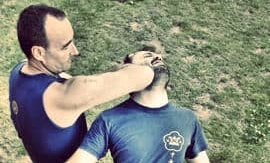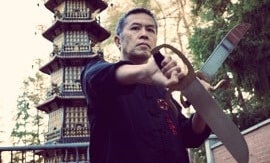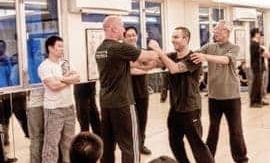
SIFU ALLAN LEE STARTED LEARNING WING CHUN IN 1967. HE BECAME AN ASSISTANT INSTRUCTOR WHILE LEARNING FROM SIFU LOK YIU, THEN LATER BECAME A PRIVATE DISCIPLE OF SIFU IP MAN. IN 1974, WITH THE BLESSING OF SIFU IP MAN, HE SOUGHT OUT SIFU DUNCAN LEUNG IN THE HOPES TO COMPLETE HIS STUDIES IN THE ART OF WING CHUN.
What kind of teacher was Grandmaster Ip Man?
Sifu was a traditional, extremely well educated, refined and humble man. He also possessed an unparalleled knowledge of martial arts and a stunning level of skill in Wing Chun. When he gave an explanation, he did so with an incisive and concise analysis insight that could only have come from a lifetime of experimentation, fighting, research and above all, diligent training.
The most outstanding characteristic of Sifu Ip Man was that he could explain complicated theories, philosophies and concepts by using analogies in a genuinely simple and straightforward way that students could easily digest. Listening to Sifu Ip Man speak always made you feel privy to the true essence of the Wing Chun style. Although I would not say that Sifu was a very strict teacher, he did expect his students to train diligently and do their own research with common sense after receiving his instruction. He encouraged his students to try it out themselves, rather than to simply believe what he taught as true. I recall Sifu Ip Man being keener on sharing his knowledge of the art to those who diligently followed his advice.
Why did you feel that your Wing Chun was lacking something after a couple years training?
Everything I learned worked within our own schools. I was very good at it and I trained very diligently. But when I went to try my skills with different martial artists, I quickly saw that I lacked certain instincts and reflexes. For instance, I felt the full effectiveness of the Chasing Punches when I managed to hit the opponent. However, at times I would get hit as well, which would then cast a shadow of doubt as to who really won the fight. This was because Sifu Ip Man had taught us that the major idea behind Wing Chun was how to fight without exchanging hits.
In a real fight, I learned that nobody would play by the same rules of the game as a Wing Chun practitioner did. Unlike my training partners at school, an opponent would seriously try to hit me. Most people believe what they learn will work just as effectively in a real fight, especially if there are sound theories supporting their learning. But fighting happens so fast—almost as if in a split second. Real fighting requires you to respond precisely and correctly with your instincts; your reactions should be like second nature. This is how I found out I was truly lacking something in my training at that time.
Tell me what it was like when you first arrived in the United States and how you were able to set up your own Wing Chun school?
When I first arrived in the United States, it was at a time when Gung Fu was very popular. Everybody was talking about Gung Fu fighting and the legacy of Bruce Lee; and since he learned Wing Chun, it made Wing Chun very popular too.
At first, I didn’t have my own school. At Sifu Duncan’s request, I started teaching as an assistant instructor at 3 Great Jones Street in Greenwich Village. Before I was ready to open up my own school, I felt that I needed to polish my English and do some more research into the proper terminology to express the esoteric and complicated philosophies behind Wing Chun. Sifu Duncan taught me how to become a much better martial artist than I was already capable of being. He personally showed me how to technically and practically apply the art of Wing Chun in real fighting, after the passing of Sifu Ip Man. His genius, coupled with his extensive collection of personal fighting experience and specialisation in Long-Bridge fighting methods, laid the groundwork for establishing what is now known as Applied Wing Chun.
I never originally intended to teach Wing Chun as a profession. However, as I am completely enamoured with the art of Wing Chun, I decided to open up my own school. My hope was to teach those who were as dedicated as I was and cherished the art as much as I did. My school has always been a second home for these students.
Was Sifu Duncan Leung able to show you what you felt lacking in regards to applying your Wing Chun?
Absolutely! He was the one who broadened my understanding, and who later paved the way for me to develop my own essence for Wing Chun. Sifu Duncan’s methodology in Wing Chun synthesises the theory and application that allowed me to fight different types of martial artists both practically and successfully.
For instance, he would show us how to effectively counter different martial art styles, including their special techniques and fighting methods such as Karate, Taekwondo, Western Boxing, Muay Thai boxers, Grappling, amongst many others. In addition, he showed me his many unparalleled and tough training programmes, in the Wing Chun system. All of these programmes were essential to deepen my understanding of how to practically use Wing Chun.
Over many years I have had the opportunity to observe many Wing Chun schools, and I subsequently know many instructors personally, though I have never encountered anyone other than Sifu Duncan who incorporated these methods into their Wing Chun curriculum.
What is Applied Wing Chun?
Like many other schools, we emphasise learning and understanding the theories that are inherent in Wing Chun. However, I personally feel theories should also be subjected to rigorous experimentation to prove that they are valid. I suppose we can say that Applied Wing Chun schools approach such theories using the scientific method. We take theory and we keep applying it until we can personally and conclusively verify its proficiency and effectiveness.
Applied Wing Chun is the art that Sifu Ip Man personally imparted to Sifu Duncan, which is taught according to a systematic curriculum previously compiled by Sifu Duncan based on his own life experiences. To the best of my knowledge, I have not heard of any other school that is conducted in such a manner.
In addition to learning the three empty-hand forms, Chi Sau and sparring, Applied Wing Chun schools undergo training in applied Short and Long-Bridge fighting. However, we strongly emphasise the usage of Long-Bridge fighting together with a series of special training programmes. Our curriculum is designed to teach students the theory, techniques, and the elements of fighting, all step-by-step. In my opinion, no martial art curriculum is complete without all three of these components.
How does Applied Wing Chun differ from what you were taught by Sifu Ip Man and Sifu Lok Yiu?
Sifu Lok Yiu emphasised mostly Short-Bridge (close-range) fighting. When I learned from Sifu Ip Man, he was at an advanced age and was unable to fully demonstrate a lot of the tough training techniques, drills, and training programmes. He verbally instructed me through these methods, but without someone actually standing by my side teaching and correcting me hands-on it was difficult to fully understand and develop a knack for how to truly apply them. Before he passed away, Sifu Ip Man told me to seek out a person like Sifu Duncan to physically show and teach me the process of adapting and applying the above-mentioned techniques, drills, and programmes in a real fight.



















